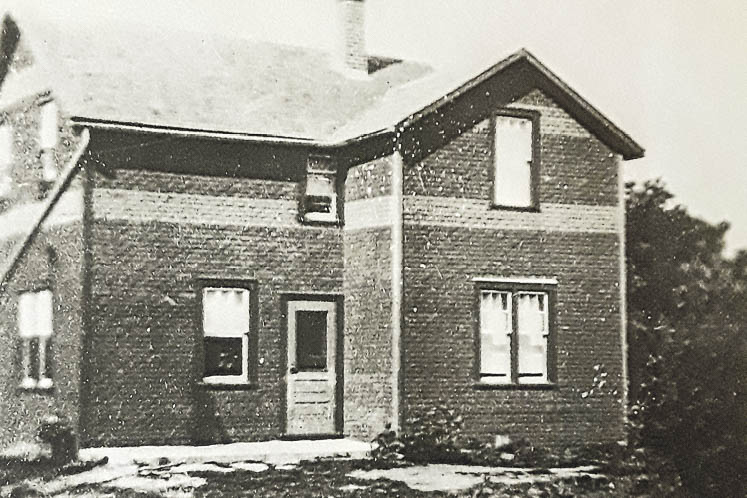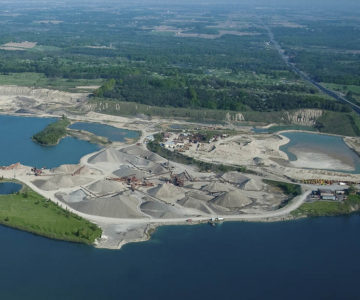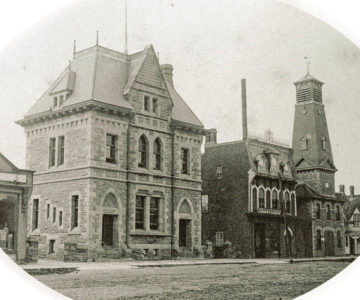Letters – Our Readers Write: Winter 2022
Letters published in the Winter 2022 edition of In The Hills magazine.
The Rise and Fall of the Rural Post Office
I read with great interest Ken Weber’s article on “The Rise and Fall of the Rural Post Office” [Historic Hills, autumn ’22]. I own and live in the house that he mentions was once the Amaranth Station post office.

The old Amaranth Station Post Office, circa 1880. Image courtesy Joanne Ison.
I moved here in 1993 and inherited a brief written and pictorial history of the property kept by the local historian Ann McPherson. That history articulates who owned/lived in the house and ran the post office from it.
I also found more info on the post office history of Amaranth Station in a Grey, Bruce, Dufferin & Simcoe railway newsletter (No.17), written in November 2000. It lists all the postmasters and postmistresses from the opening of the Amaranth Station post office in May 1874 to its closing September 1950.
I feel privileged to own and live in a home with the history and longevity my house has.
Joanne Ison, Amaranth
So, this is where our father was born! The Orangeville post office! We were always told of this event on September 22, 1900. His father, Dugald Macpherson, was the caretaker, and our dad, the youngest of six living brothers, was teased by those brothers that he was “delivered” by mail. Later on, when Dad was in high school, Grandpa became the first librarian in the new Carnegie library, where after school, Dad and his brothers filed books that had come from the Mechanics Institute according to the Dewey Decimal system, and other sundry tasks, as the librarian was also caretaker and secretary of the board.
Janet Dobrowski, Orangeville
Pit by Pit
I was deeply impressed with “Pit by Pit” [autumn ’22] by Nicola Ross. It’s impeccably researched, presents a well-balanced perspective and, perhaps best of all for the readers, it’s really entertaining.
I’d have to say my favourite quote was, “Amid these forces, the latest aggregate battle brewing in Cataract will test Caledon’s image of itself with unprecedented intensity.” The quote is particularly germane when we ask ourselves, do we really want Caledon to become a full-on “mining town”? Thank you for this terrific piece of journalistic enlightenment.
David Sylvester, Forks of the Credit Preservation Group, Caledon
“Pit by Pit,” your overview of Caledon’s aggregate saga, deserves a wide audience, at least to every MLA at Queen’s Park. I learned a great deal more about what is unfolding on this front. In the 1970s, I was at a cottage on Nellie Lake, outside Iroquois Falls, staying with friends, I thought anonymously, when a telephone call came through from NASA (no idea of how they found me, perhaps through my employer, the ROM, via a family member), telling me they were ground-truthing some of their early satellite imagery, and they had just located a notably huge and apparently manmade object – one of the largest they couldn’t account for – in southcentral Ontario, and they were wondering if I could help them identify it. It was Caledon, the pits already in operation in the 1970s. I’ve never forgotten how NASA knew as much or more about the far-flung Caledon aggregate operations than the average Ontario citizen did. It’s still the case, more’s the pity.
John Riley, Mono
Re “Pit by Pit”: Congratulations on a well-researched and well-written piece. I’m glad that [former] Caledon councillor Ian Sinclair is helping out the group. I love the aerial photo/map – probably the first time I’ve seen such a map. The land of square lakes indeed.
Linda Pim, Inglewood
Thank you for a well-balanced report on aggregate extraction. As I live just north of Caledon and am half-surrounded by a gravel pit and an aggregate reserve, I’m aware of both the benefits and hazards of aggregate extraction.
The local gravel pit is very well operated. I have no complaint, and my township regards it as a model of good stewardship. The owner assured me that it and his adjoining land reserved for aggregate extraction will not penetrate the water table. Other pits are not so well managed, and one, a few kilometres away, may be a repository for garbage, but local government is not allowed to police it.
At one time the Provincial Policy Statement said that aggregate pits must be rehabilitated to their original use – unless they penetrate the water table. As one whose well draws from the Amabel aquifer stretching between Guelph and Orangeville, I’m concerned about the inevitable garbage, lubricants, etc that may be left in an aggregate pond.
I must object to assessing farmed land as a gravel pit. To anticipate future use as an aggregate pit and tax it accordingly would mean that the living earned by the farmer may be denied. Farm property taxes are high enough. As long as a piece of land is being farmed, it is a farm and must be taxed accordingly.
Charles Hooker, East Garafraxa
Editor’s note: The 2017 change to the Municipal Property Assessment formula shifted the active portion of the pit to farmland from industrial. Although the “farmland” is taxed at the industrial rate, the assessment revision does not take into account the value of the aggregate.
Re “Pit by Pit”: Thanks for this great article. In addition to immediate operational challenges, there are issues with a lack of timely and effective site reclamation. See the 2022 video and report called Landscape Impacts of Aggregate Extraction in the Credit, available under Blog in the menu at ontarioheadwaters.ca
Andrew McCammon, The Ontario Headwaters Institute
Related Stories

Pit by Pit
Sep 20, 2022 | | EnvironmentAs another battle over aggregate mining gears up in Cataract, the question remains: how do we balance our voracious demand for aggregates with the rights of local citizens and nature?

The Rise and Fall of the Rural Post Office
Sep 20, 2022 | | Historic HillsBefore rural mail delivery was established in the early 1900s, nearly every village and hamlet in these hills had a post office.







The Rise and Fall of the Rural Post Office. In the Winter 2022 issue of In the hills a letter to the editor talked about the Amaranth Station post office. The office opened on 1874-05-01. I have the earliest reported postmark for this office. 1875-04-26. I collect Dufferin County Postal History and research post offices in Dufferin County.
George Power from Mulmur Township on Mar 17, 2023 at 3:32 pm |